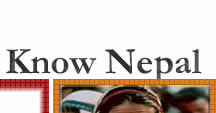


Nepal is a topographically diversified kingdom comprising 147,181 square kilometres of land. Located between India and China, it features three distinct regions: snow-capped, towering Himalayan peaks in the north; mountains and hills in the center; and agriculturally fertile flatlands (Terai) in the south.
Latitude - 26° 22' N to 30° 27'
N
Longitude - 80° 4' E to 88° 12' E
Area - 147,181 sq. kms.
Length - 885 kms. East to West
Width - non-uniform, mean width of 193 kms. North to South
Population- 21.3 million
Temperatures in the flat Terai on Nepal's Southern border range from 7-23 degrees Centigrade in winter to 40 degrees in summer. In the hills temperatures vary between highs of 25-27 degrees in summer, and winter lows of sub-zero to 12 degrees. The Kathmandu Valley, maintains a pleasant climate of 19-33 degrees in summer, and 0-12 degrees in winter.
Winter (December-February) - 1°C to
3°C
Summer (March-May) - 24°C - 32°C
Monsoon (June-August)
Autumn (September-November) - 10°C- 18°C
Nepal is one of the few nations in the world which has always remained independent. King Prithvi Narayan Shah, the Great, unified Nepal's many small principalities into one nation in 1769. After the Anglo-Nepal War of 1814-1816 Jung Bahadur Rana established his family as hereditary prime ministers who controlled the country until 1951. King Tribhuvan, the present king's grandfather, subsequently led a popular uprising overthrowing the family autocracy and establishing Nepal as a monarchy with a multiparty system. This regime was replaced by the party-less 'Panchayat' system in 1960 by his son, the late King Mahendra. In 1990 a popular movement re-established Nepal's multiparty democratic system and the kingdom became a constitutional monarchy.
The people of Nepal constitute a rich ethnic mix which reflects Nepal's position as cross-roads between India, Tibet and Burma. The country's inhabitants are predominantly Hindu, although Buddhists (8%), Christains, Muslims and others form a noticeable presence. Nepal's present population is 22 million, with the annual growth at 2.3 percent.
The country uses the metric system for most formal measurements. Its time
is five hours and forty-five minutes ahead of GMT.
The Exchange rate : 1US$=NC Rs.74.25paisa.

The country’s gross domestic product (GDP) was $5.5 billion in 2002, with an estimated per capita GDP of $230.
Agriculture dominates Nepal’s economy. It provides a livelihood for 79 percent of the population and contributes 41 percent of GDP. The Tarai is the main farming region of the country. Rice and corn are major food crops; potato, oilseed, sugarcane, jute, and tobacco are major cash crops. Nepal’s industrial base is limited. Most industries are based on agricultural raw materials or dependent on various imported materials, mostly from India. Major manufactured products include jute, sugar, cigarettes, beer, matches, shoes, cement, and bricks. Traditional cottage industries such as basket and carpet weaving are also important to Nepal’s economy.
